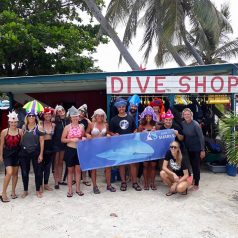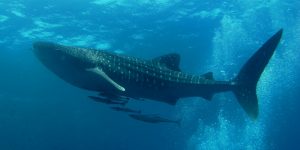
On Sunday evening, the third edition of the Dutch Caribbean Shark Week concluded with a sunset shark dive on Saba. The week was an initiative of the Save Our Sharks Sharks campaign, organized simultaneously in the Netherlands, Saba, St. Eustatius, St. Maarten, Aruba, Bonaire, and Curacao.
The goal of Dutch Caribbean Shark Week was to raise awareness about the plight of sharks and their importance to the health of marine ecosystems and as a tourism asset. This year, extra attention was paid to the status of shark populations in both the Netherlands and the Caribbean. A Kingdom Shark Count weekend happening throughout the Kingdom was part of this. During various activities in the second weekend of Shark Week, sharks were counted in the waters around Saba, Sint Maarten, Curaçao, and the Netherlands. Because it’s not just our tropical seas that are popular with these impressive animals.
Kingdom Shark Count
This was the first time that a Kingdom Shark Count was organized. Fishermen, diving schools, and tour operators, as well as volunteers and scientists, kept track of how many sharks they encountered during their work or specially organized sharking activities.Over the past few years, an increasing amount sharks are being observed in the Dutch North Sea coast. But little research is being done here. Save Our Sharks would like to stimulate this research and, with the Kingdom Shark Count, made a first move.
Results

On the Eastern Scheldt, for example, there was a shark tagging trip where eleven starry smoothhounds were tagged for research by the Dutch Angling Association. On the Wadden Sea, shrimp fishermen kept track of the sharks that were caught as bycatch. Among other things, they encountered two very young tope sharks. This is special because it’s a species we know little about and the presence of such young animals suggests that the Wadden area may be a pupping ground for this species, which grows up to two meters. However, that size is nothing compared to the whale shark, the world’s largest fish species. This shark can grow over 18 meters long. Whale sharks do not often show themselves the Dutch Caribbean, but over the last week, two individuals were seen near Bonaire and Aruba. Charismatic species such as Caribbean reef sharks and tiger shark also popped up occasionally.
Irene Kingma, project manager of Save Our Sharks in The Netherlands: “We can conclude that we have some rich and diverse shark populations in our waters. However, extensive research is needed to find out what the status is of these populations. We hope to find out more about the Dutch sharks and rays this year with cooperation with fishermen. Also, little is known about the sharks and ray species around the Dutch Caribbean islands. Therefore, there has been baseline study was conducted in the waters around Aruba, Bonaire, Curaçao, St. Maarten, St. Eustatius and Saba to get an indication of the species occurring there. This research was finalized last month. At the moment, the data is analyzed and over the summer, we hope to be able to share the first results. But I’m optimistic after the first results of the Kingdom Shark Count. “





